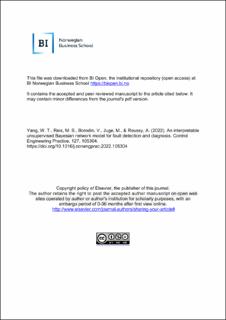| dc.contributor.author | Yang, Wei-Ting | |
| dc.contributor.author | Reis, Marco | |
| dc.contributor.author | Borodin, Valeria | |
| dc.contributor.author | Juge, Michel | |
| dc.contributor.author | Roussy, Agnès | |
| dc.date.accessioned | 2023-08-22T12:04:43Z | |
| dc.date.available | 2023-08-22T12:04:43Z | |
| dc.date.created | 2022-09-06T14:05:51Z | |
| dc.date.issued | 2022 | |
| dc.identifier.citation | Control Engineering Practice. 2022, 127 . | en_US |
| dc.identifier.issn | 0967-0661 | |
| dc.identifier.uri | https://hdl.handle.net/11250/3085257 | |
| dc.description.abstract | Process monitoring is a critical activity in manufacturing industries. A wide variety of data-driven approaches have been developed and employed for fault detection and fault diagnosis. Analyzing the existing process monitoring schemes, prediction accuracy of the process status is usually the primary focus while the explanation (diagnosis) of a detected fault is relegated to a secondary role. In this paper, an interpretable unsupervised machine learning model based on Bayesian Networks (BN) is proposed to be the fundamental model supporting the process monitoring scheme. The proposed methodology is aligned with the recent efforts of eXplanatory Artificial Intelligence (XAI) for knowledge induction and decision making, now brought to the scope of advanced process monitoring. A BN is capable of combining data-driven induction with existing domain knowledge about the process and to display the underlying causal interactions of a process system in an easily interpretable graphical form. The proposed fault detection scheme consists of two levels of monitoring. In the first level, a global index is computed and monitored to detect any deviation from normal operation conditions. In the second level, two local indices are proposed to examine the fine structure of the fault, once it is signaled at the first level. These local indices support the diagnosis of the fault, and are based on the individual unconditional and conditional distributions of the monitored variables. A new labeling procedure is also proposed to narrow down the search and identify the fault type. Unlike many existing diagnosis methods that require access to faulty data (supervised diagnosis methods), the proposed diagnosis methodology belongs to the class that only requires data under normal conditions (unsupervised diagnosis methods). The effectiveness of the proposed monitoring scheme is demonstrated and validated through simulated datasets and an industrial dataset from semiconductor manufacturing. | en_US |
| dc.language.iso | eng | en_US |
| dc.publisher | Elsevier | en_US |
| dc.rights | Attribution-NonCommercial-NoDerivatives 4.0 Internasjonal | * |
| dc.rights.uri | http://creativecommons.org/licenses/by-nc-nd/4.0/deed.no | * |
| dc.subject | Bayesian Network (BN) | en_US |
| dc.subject | eXplanatory Artificial Intelligence | en_US |
| dc.subject | Fault Detection | en_US |
| dc.subject | Interpretable Machine Learning | en_US |
| dc.title | An interpretable unsupervised Bayesian network model for fault detection and diagnosis | en_US |
| dc.title.alternative | An interpretable unsupervised Bayesian network model for fault detection and diagnosis | en_US |
| dc.type | Peer reviewed | en_US |
| dc.type | Journal article | en_US |
| dc.description.version | acceptedVersion | en_US |
| dc.rights.holder | Elsevier | en_US |
| dc.source.pagenumber | 17 | en_US |
| dc.source.volume | 127 | en_US |
| dc.source.journal | Control Engineering Practice | en_US |
| dc.identifier.doi | 10.1016/j.conengprac.2022.105304 | |
| dc.identifier.cristin | 2049210 | |
| cristin.ispublished | true | |
| cristin.fulltext | postprint | |
| cristin.qualitycode | 1 | |

